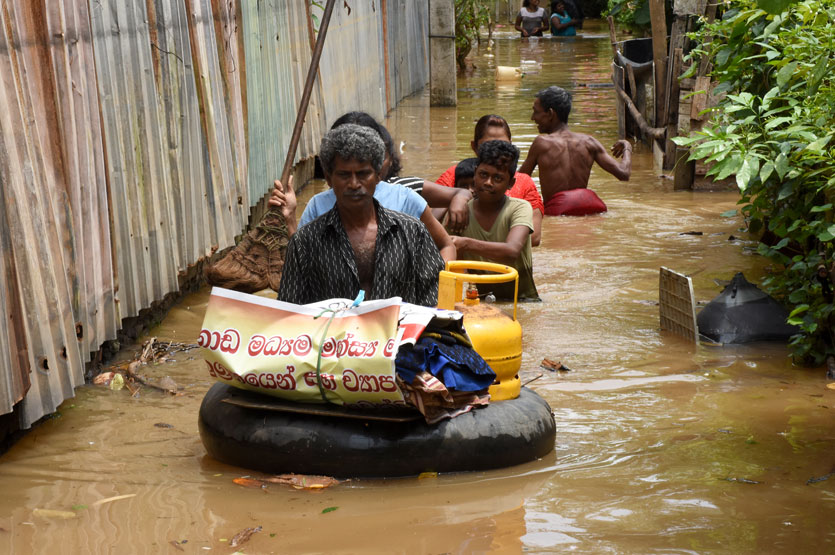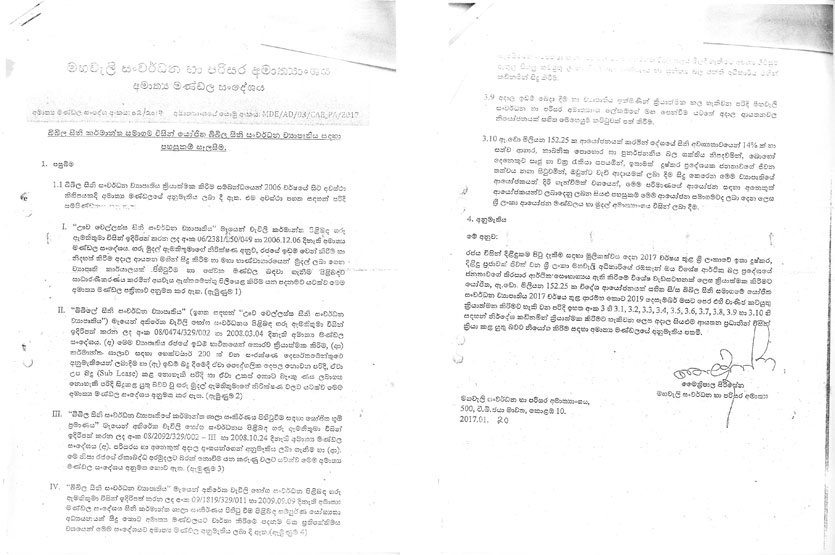Jun 02 2017.
views 1899When protecting the Earth becomes an option...
Sri Lanka witnessed a series of tragedies this year from the collapse of the Meethotamulla garbage dump to the prevailing floods. While the garbage dump was entirely a man-made tragedy, Life Online learns that we humans have contributed to the impending calamity as well. While many mega development projects are mushrooming across the island, the environment too needs to be given its place. In view of World Biodiversity Day which falls on June 5, we compiled a series of incidents which have become serious issues or are under-hand deals which will never be reported.
The Centre for Environmental Studies (CENS) headed by passionate environmentalist Ravindra Kariyawasam has been actively involved in investigating on various mega development projects which have already begun or are yet to begin.
The following are some reports which we gathered during the past few months.
Floods: A man-made disaster?
Heavy showers experienced throughout the island resulted in floods and landslides, burying many lives under soil and water. In the latest situation report issued by the Disaster Management Centre (DMC), the death toll has increased to 180 while 110 people have gone missing and in total, 588,082 people of 153,303 families had been affected by the weather calamity. As identified by CENS, the prevailing situation in the country was 'designed' by the people themselves. In their reports it has been mentioned that the National Physical Plan which has been implemented from 2011-2030 will present a number of environmental hazards in future as well.

(Photograph by Kushan Pathiraja)
· There are riffles and pools in the midstream of every river. But according to research conducted by CENS, these riffles and pools of rivers have been covered by concrete buildings, roads and micro-hydro projects. As a result, people have blocked water feeding channels, for example in the Kelani River.
· Transport in sediments in rivers come from flood plains; erosion and construction around rivers have increased the probability of experiencing floods and landslides in Sri Lanka. For example, due to the construction of Pico hydro power project on top of the Laxapana water fall and Kitulgala, the Kelani River receives tons of sediments.
· A floodplain is the neighboring part of a river or stream. This stretches from the banks of its channel to the base of the enclosing valley walls and experiences flooding during periods of high discharge. The floodplains of the Kelani River are located from Kaduwela Bridge to tributary of Kelani River. The encroachment of floodplain has caused massive disaster. Many flood plains have been used to build homes and other projects.
The fate of the Muthurajawela wildlife sanctuary
With the collapse of the Meethotamulla garbage dump, several concerns were raised as to where all the garbage would go next. While several areas were proposed including Karadiyana, Dompe, Uswatekeiyawa, Veyangoda and Kotikawatte the residents of these areas protested against this decision. As a result Muthurajawela and Aruwakkalu too were proposed as sites for dumping garbage.
Muthurajawela is the largest saline coastal peat bog in Sri Lanka, located on the west coast between the Negombo Lagoon and Kelani River, spreading inland up to Ragama and Peliyagoda in the Gampaha district. The marsh together with the Negombo Lagoon forms an integrated coastal wetland eco-system.
The northern section of the marsh covering an area of 1,777 hectares was declared a sanctuary in July 1996 under the Fauna & Flora Protection Ordinance. A variety of mangroves and other types of flora including medicinal plants are found alongside numerous types of endemic birds, butterflies and fish. At the onset of the incident, the Bopitiya area which is located adjacent to the wetland was identified as a landfill site and work already commenced. According to media reports, however the garbage dumping has begun without seeking prior approval from the authorities.

Speaking to Life Online, senior environmental lawyer Jagath Gunawardena said that still the specific area demarcated for this purpose is unknown. "All I could say is that if they dump garbage in the area that has been specified as the buffer zone or the sanctuary, it will be an offence under the Nature Protection Act and the Flora and Fauna Protection Ordinance respectively. But if they dump garbage in the area earmarked as the sanitary landfill site they could do so after conducting an Environmental Impact Assessment (EIA)."
Wellassa land grabbing for sugarcane cultivation
In another incident reported by CENS, Life Online also learned that approximately 62,000 acres of land will be sold out to an American company for a proposed sugarcane cultivation project. According to sources the agreement will be officially signed on June 5, 2017. The transaction will be carried out by a Singaporean company named Gazelle Ventures while its local counterpart is alleged to be IMS Holdings Pvt. Ltd. The details have thus been disclosed in the cabinet paper number MDE/AD/03/CAB-PA/2017.

CENS further reported that lands from Maha Oya, Padiyathalawa, Rideemaliyadda, Badulla, Mahiyanganaya, Monaragala and Bibila have been identified for this purpose. In addition to that approximately 370 acres from the Maduru Oya forest reserve has been allocated for this project. The above mentioned areas are the only habitats left for elephants to dwell in. but once they are cleared the human-elephant conflict will once again come to the limelight.
In an attempt to discourage the villagers from protesting against this project, close to 10,000 families in the farming sector have been promised 2 ½ hectares of land for cultivation purposes, CENS reports observe. The Pelawatte, Hingurana and Kantale areas which already have started sugarcane cultivations experience severe human-elephant conflicts. Since sugarcane is a favourite diet among elephants and since their habitats have been cleared several casualties have been reported, including both humans and elephants.
Elephants to be given to private owners and institutions
The cabinet recently granted approval to hand over some elephants at the Pinnawala orphanage to individuals and religious places of worship under 'strict conditions'. The approval was granted on a proposal made by the Minister himself, reason being the issue of overcrowding at the orphanage. The cabinet paper further mentioned that it was difficult to accommodate 88 elephants within a 30 acre premises. Furthermore it has identified the difficulties in keeping male and female elephants together and has requested institutions and private owners to claim ownership for new-borns.
· The paper further indicates that the amended Flora and Fauna Protection Ordinance (2009) clause 22A (12) states that elephants are public property and therefore will not be given for ownership by private parties.
· The elephants will be given away to private owners who pay a sum of Rs. 10 million and this is negligible for places of religious worship.
· A certain criteria have to be met and agreed upon when claiming ownership of the elephant. (refer cabinet paper here)
· Owners should also fill in the form to mention their eligibility to adopt and take care of the elephant.
· A selection committee would be appointed by the Cabinet to select the eligible applicants.
Speaking to us on this regard, Attorney-at-law Jagath Gunawardena said that still it is unclear as to what is going on about this matter. "We raised our concerns against this incident but so far nothing has been done. Three years ago the Pinnawala orphanage requested elephants to be brought down from the Eth Athuru Sevana saying that they were short of elephants. My question is that if they have more elephants why did they make such a request?"
Several attempts to contact Wildlife and Sustainable Development Minister Gamini Jayawickrama Perera to inquire about the sugarcane cultivation project and the ownership of elephants, failed.
0 Comments